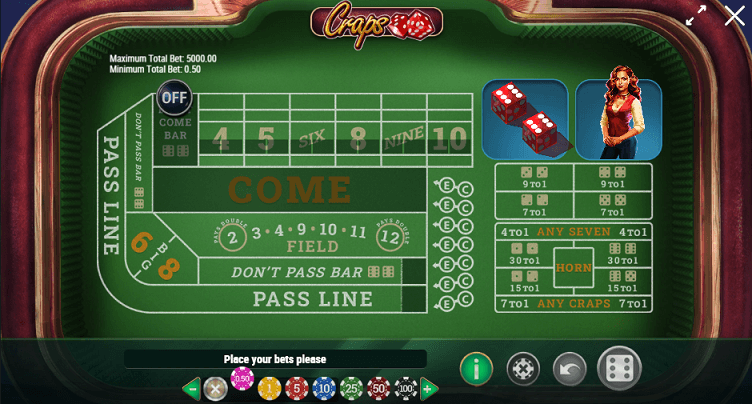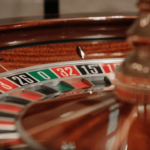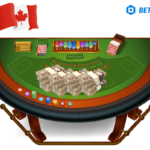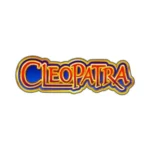Nowadays, craps reigns supreme as the go-to dice game in Canadian casinos. The version we delight in today has its roots in an ancient 1700s game known as 'Krabs,' itself an evolution of the English game 'Hazard.' In early North America, craps found its footing between 1800 and 1810 in the bustling streets of New Orleans, brought over by a prosperous Louisiana family. The introduction of craps to the American continent is attributed to Bernard de Marigny de Mandeville, who tweaked the original 'Hazard' game to simplify its intricacies. Initially snubbed by the upper crust of Louisiana in the 1800s, craps soon charmed the working class, becoming a staple among fieldhands and deckhands across the region. The game's peculiar moniker originates from the French word 'crapaud,' meaning 'toad,' a nod to how players crouched when casting the dice. Upon realizing the game's burgeoning appeal, de Marigny christened a street in his beloved New Orleans 'Rue de Craps,' cementing its street origins in casino lore. By the 1850s, craps tables were a fixture in many casinos, making it trendy among both the middle and upper echelons of society. craps The outbreak of the Second World War saw American and Canadian soldiers embrace craps, popularizing the street version before they were stationed overseas.
A Thorough Guide to Craps for Canadian Enthusiasts
Last update: February, 2025

In the post-World War era, craps surged to become a favored table game across North America, making a notable mark in Las Vegas, Nevada, while continuing its acclaim in established gambling venues. With the advent of digital casinos, players can now engage with live dealer and RNG versions of craps. If you've ventured into Canadian casinos, whether digital or physical, chances are high that you've encountered craps. So, what's the essence of the game, and which rules are essential for mastering this classic casino experience? Canadian casinos This extensive guide provides a complete breakdown of playing craps online or at land-based casinos. Additionally, it offers strategic insights to boost your winning probability and shares handy tips to enhance your gameplay. Before staking your chips at the craps table, it's crucial to get a grasp on the fundamental rules and intricacies of the game. Here, we outline the core rules and table setup, followed by an exploration of the various craps bets available in online casino settings.
Basic Rules & Gameplay
Two dice, a specialized table, and chips of different values form the essentials for a craps game. The primary goal is to forecast the total value achieved by the dice after the shooter throws them.
Basic rules of craps
- A standard craps game includes multiple betting phases, and can accommodate up to 20 players simultaneously.
- Kickoff every craps session with a pass line wager. This bet predicts if the dice will show a 7 or 11, signaling a 'pass,' or a 2, 3, or 12, indicating 'no pass.'
- The game begins with a 'come out roll,' where the first selected shooter rolls the dice.
- A total of 7 or 11 on this roll means instant victory for pass line bets, while a total of 2, 3, or 12 wins for don't pass bets.
- Should the dice total a different number, any active pass or don't pass bets are carried over to future rounds, and this number is designated as 'the point' for the game's duration.
- Players may adjust their bets to wager on different numbers once the point is determined.
- Dice rolling continues until either the point is rolled or a seven shows up.
- After that, the game resets, and the responsibility passes to another shooter.
- With the basics covered, let's dive deeper into the craps table design. Standard tables are symmetrical in layout, accommodating more player engagement in physical casinos. When observing a craps table, expect to find these sections:
- Most craps tables have a pass & don't pass area in the lower left. This section holds a popular beginner-friendly bet. A pass line bet predicts a roll of 7 or 11, while a don't pass wager looks for a 2, 3, or 12.
Craps table layout
Adjacent to the pass lines are the Big 6 and Big 8 areas. Here, place your chips if you anticipate a roll of six or eight coming before a seven.
Types of Bets
A come out roll summing to two or three rewards a don't pass wager with a return of 1:1. Rolling a 12 results in a push. Other numbers must precede a seven for a payout.
Pass Line Bet
| Type of bet | Numbers | House edge | Payout |
| Multi-roll | 7 or 11 | 1.41% | 1:1 |
A come bet requires the point be set beforehand, and mirrors a pass line bet by wagering on 7 or 11 appearing.
Don’t Pass Line Bet
| Type of bet | Numbers | House edge | Payout |
| Multi-roll | 2, 3, 12 | 1.36% | 1:1 |
A don't come bet, conversely, places faith in a 2 or 3 emerging after the point is specified, with a 12 causing a no-action result.
Come Bet
| Type of bet | Numbers | House edge | Payout |
| Multi-roll | 7 or 11 | 1.41% | 1:1 |
Field bets are appealing because they involve betting on specific numbers to arise post-dice roll. They typically payout at 1:1, but select numbers like 2 or 12 might result in 2:1 returns.
Don’t Come Bet
| Type of bet | Numbers | House edge | Payout |
| Multi-roll | 2, 3, 12 | 1.36% | 1:1 |
Once a pass or come bet is made, odds can be laid—betting that the shooter will land a 7 before reaching a point, a strategic opportunity due to its zero house advantage.
Field Bets
| Type of bet | Numbers | House edge | Payout |
| Single roll | 3, 4, 9, 10, 11 (2, 12) | 5.5% | 1:1 (2:1 for 2, 12) |
Indeed, placing bets remains permissible throughout craps, with added popularity once a point is in play—selecting a number to appear before a 7 holds varied house odds.
Laying the odds
| Type of bet | Numbers | House edge | Payout |
| Multi-roll | 4/10, 5/9, 6/8 | 0% | 4/10 (1:2), 5/9 (2:3), 6/8 (5:6) |
Similar to place wagers, buy bets target specific numbers preceding a 7. Be cautious of potential 5% commissions applied by some venues when these win.
Place Bets
| Type of bet | Numbers | House edge | Payout |
| Multi-roll | 6/8, 5/9, 4/10 | 6/8 (1.52%), 5/9 (4%), 4/10 (6.67%) | 6/8 (7:6), 5/9 (7:5), 4:10 (9:5) |
Feeling confident about a six or eight preceding a seven? Then Big 6 or Big 8 wagers in craps can yield even money.
Buy Bets
| Type of bet | Numbers | House edge | Payout |
| Multi-roll | 4/10, 6/8, 5/9 | 4.76% | 4/10 (2:1), 6/8 (6:5), 5/9 (3:2) |
Hardways revolve around distinct twin dice rolls, such as hitting a hard 6, 8, 4, or 10. Victory ensues if these numbers show before a 7.
Big Six, Big Eight Bets
| Type of bet | Numbers | House edge | Payout |
| Multi-roll | 6, 8 | 9% | 1:1 |
Seemingly elusive, rolling a 2 or 12 in craps offers enticing odds of 30:1, attributed to their limited possible combinations.
Hardways Bets
| Type of bet | Numbers | House edge | Payout |
| Multi-roll | 6/8, 4/10 | 6/8 (9.09%), 4/10 (11.11%) | 6/8 (9:1), 4/10 (7:1) |
Focusing on 3 or 11 bets offers worthwhile 15:1 returns. While they're more feasible than 2 or 12 bets, their lucrative outcomes remain attractive.
2 or 12 Bets
| Type of bet | Numbers | House edge | Payout |
| Single roll | 2, 12 | 13.89% | 30:1 |
Craps revolves around sevens, a number with ample combinations, prompting bets on any seven with 4:1 odds.
3 or 11 Bets
| Type of bet | Numbers | House edge | Payout |
| Single roll | 3, 11 | 11.11% | 15:1 |
'Any craps' bets cover a roll of 2, 3, or 12 and offer an intriguing 7:1 payout potential.
Any 7 Bet
| Type of bet | Numbers | House edge | Payout |
| Single roll | 7 | 16.67% | 4:1 |
Your Ultimate Canadian Craps Handbook - Betsquare 2025
Any Craps Bets
| Type of bet | Numbers | House edge | Payout |
| Single roll | 2, 3, 12 | 11.11% | 7:1 |
Dive into our thorough manual to master both online and offline craps. Explore how the game operates, uncover odds, examine potential payouts, and delve into probabilities.
Craps bet types overview
The Definitive Canadian Craps Handbook
| Bet Type | House Edge | Potential Payout |
| Pass line | 1.41% | 1:1 |
| Don’t pass line | 1.36% | 1:1 |
| Come | 1.41% | 1:1 |
| Don’t come | 1.36% | 1:1 |
| Field | 5.50% | 1:1 / 2:1 |
| Laying the odds | 0.00% | 1:2 / 2:3 / 5:6 |
| Place | 1.52% – 6.67% | 7:6 / 7:5 / 9:5 |
| Buy | 4.76% | 2:1 / 6:5 / 3:2 |
| Big Six, Big Eight | 9.00% | 1:1 |
| Hardways | 9.09% – 11.11% | 7:1 / 9:1 |
| 2/12 | 13.89% | 30:1 |
| 3/11 | 11.11% | 15:1 |
| Any 7 | 16.67% | 4:1 |
| Any craps | 11.11% | 7:1 |
Craps Strategies
At Betsquare, our editorial team holds independence and objectivity in the highest regard. To finance our reviews and provide this free content, we receive compensation from advertisers featured on our site, sourced primarily in two ways. The first source involves paid placements for advertisers; these have the potential to influence the offers depicted on our website. Not every product or service available elsewhere is showcased on Betsquare.
The pass line craps strategy
Moreover, some articles may include links to advertiser offers—known as 'affiliate links'—which can earn us commission if clicked. While these compensations help us support the website, they do not sway the editorial team's recommendations or advice. Additionally, the completeness or accuracy of all information cannot always be guaranteed by Betsquare. Check below for our partners supplying affiliate-linked products. Mastering Baccarat in Canada with Betsquare These days, craps reigns as the top dice game in Canadian casinos. Its modern form evolved from an 18th-century game called 'Krabs,' which itself is a variant of the classic English game, 'Hazard.'
The don’t pass craps strategy
The introduction of craps to North America traces back to circa 1800-1810 in New Orleans, thanks to a prominent landowning family in colonial Louisiana. Bernard de Marigny de Mandeville is famed for transporting the game to North America. Upon its arrival in Louisiana, he tweaked Hazard for simplicity, resulting in craps. Initially, Louisiana's elite dismissed craps, but it quickly caught on among the working class and was played by deckhands and fieldhands throughout the state. The game borrows its unique name from the French 'crapaud,' meaning 'toad'—a nod to the players' crouched postures while rolling dice on the ground.
The six and eight craps strategy
Recognizing its appeal, de Marigny even named a New Orleans street 'Rue de Craps,' cementing its reputation as a casino game born from the streets. Throughout the mid-1800s, craps gained traction as a table game in many casinos, attracting middle and high society alike. Craps took on immense popularity during WWII, played by North American soldiers who remembered the street version from New Orleans. In the war's aftermath, craps surged as a beloved casino staple across North America, with particular growth in Las Vegas, Nevada. From physical venues to digital platforms, craps is now a staple both live and via RNG across online casinos. Chances are high that, whether online or on the casino floor in Canada, you've encountered the dice-rolling excitement of craps. But what's the essence of this game? What are the rules you'll need to dive into this classic brand of casino entertainment?
The iron cross craps strategy
Within this expansive guide, we're breaking down everything necessary to engage in craps online or offline. You'll also discover smart strategies to boost your victories and handy tips to enhance your enjoyment of this classic casino dice game. Prior to wagering at a craps table, it's crucial to comprehend the foundational rules and game mechanics. In this section, we unravel craps' essential regulations and table layouts, before spotlighting different bet types available in online play. Craps revolves around two dice, a single table, and a varying range of chips. The game's core objective is predicting the involved-face outcome of the dice tossed by the shooter.
Managing your bankroll
Craps play unfolds in multiple betting rounds, accommodating up to 20 players concurrently. All sessions initiate with a pass line bet, guessing whether the dice will 'pass the line' by hitting 7 or 11, or failing with 2, 3, or 12. The game commences with a 'come out roll,' rolled by the initial shooter. Immediately after the opener, pass line bets win on a tally of 7 or 11. Successful don't pass bets reward at a count of 2, 3, or 12.
Odds and Probabilities
On landing a different number, pass/don't pass bets stay active through further rounds, with said number becoming the game's 'point.' Once established as 'the point,' bets can be customized toward varying numbers.
| Dice roll | Combination required | Probability (%) |
| 2 | 1+1 | 2.78% |
| 3 | 2+1 | 5.56% |
| 4 | 2+2 / 3+1 | 8.33% |
| 5 | 2+3 / 4+1 | 11.11% |
| 6 | 1+5 / 2+4 / 3+3 | 13.89% |
| 7 | 1+6 / 2+5 / 3+4 | 16.66% |
| 8 | 2+6 / 3+5 / 4+4 | 13.89% |
| 9 | 3+6 / 4+5 | 11.11% |
| 10 | 4+6 / 5+5 | 8.33% |
| 11 | 5+6 | 5.56% |
| 12 | 6+6 | 2.78% |
Dice keep rolling until either 'the point' hits or a seven appears. A new toss begins with the dice reissued to a fresh shooter. Having explored craps' basics, we can scrutinize the table layout. Crisscrossed sides characterize a typical craps table, facilitating more player participation at physical casinos, revealing these placement sections on a dice table's first glance:
Point number probability
Most craps tables position the pass & don't pass territory in the bottom-left corner. It's a strong beginner choice, placing stakes on hitting 7 or 11 (pass) or 2, 3, or 12 (don't pass).
| Point number | The Big 6 and Big 8 arena rests beside these lines, ready for chips if a player suspects a six or eight might strike before seven does. | Central to the table resides the field, a section offering the option to pledge on specific numbers like 3, 4, 9, 10, or 11. Doubling or tripling payouts await bets on 2 or 12. |
| 4 | 33.34% | 66.66% |
| 5 | 40.00% | 60.00% |
| 6 | 45.45% | 54.55% |
| 8 | 45.45% | 54.55% |
| 9 | 40.00% | 60.00% |
| 10 | 33.34% | 66.66% |
Activating post-point establishment, the come and don't come zones enable betting on an ensuing roll landing 7 or 11 (come) or 2, 3, or 12 (don't come). Such bets even develop personal points alongside game points, tactically broadening win prospects.
Atop sits the place spot, reserved for staging chips in anticipation of specific numbers—4, 5, 6, 7, 8, 9, and 10. Successful place bets come from landing these before hitting a seven, possible bets during any round.
Specialized wagering takes place within the central craps section, dubbed the proposition bet area. Here, one-time stake predictions include specific combo rolls like double ones or sixes. As we'd expected, craps bet patterns correspond to table segments previously discussed. Below, we dive into further detail, illuminating each associated bet type, its odds, and potential payouts to expect. A pass line wager relies on landing 7 or 11 off the come out roll, paying 1:1 if successful. Should different numbers form aside 2, 3, or 12, this wager shifts into the following round. A 1:1 payout marks don't pass bet success with come out rolls of two or three. A roll of 12 records a push bet, as if no outcome happened, while other numbers must stay hidden presettlement.
Etiquette and Casino Tips
You may only gamble a come bet once 'the point' gains establishment. Once done, a come bet aligns with the opening pass line wager's odds on 7 or 11 output.
Don’t hide the dice
A don't come bet mirrors a reversed come bet. After setting 'the point,' the next roll may bet on two or three. Should 12 result, a push bet holds.
Play at a good pace
Field bets are sought-after for enabling wagers on seen numbers during dice rolls, standard winnings being 1:1. However, 2 or 12 bets pay 2:1 for the field option.
Don’t blow on the dice
Post-pass or come bets, free odds wagers symbolize predictions on walking seven ahead of any given point, lacking house edge and thus enticingly favored in craps strategy circles.
Show respect to other players
While any craps table betability persists throughout play, heavy wagering ensues post 'point' setup. Place bets accentuate specifics—holding until predestined number resolution—evaluated differently per house edge.
Drinks don’t belong on the table
With a mindset akin to place bets, buy wagers seize specified numbers over a seven but incur a common five-percent casino commission upon winning payouts.
Look to the dealer for cues
Wagering on a dice-struck six or eight before a seven leads to so-called Big 6 or Big 8 stops; these bets yield straightforward 1:1 returns.
Watch some games before betting
'Hardways bets' translate to dual-roll configurations in the craps sphere, facilitating dice speculation such as realizing hard 6, 8, 4, or 10 prior to seven's arrival, making good their payouts.
Practice by playing online craps
As the least probable number outcomes—grabbing only two dice combos each—rolling 2 or 12 illustrate odds-producing possibilities at 30:1.
Similar in rarity to 2 and 12, a bet on 3 or 11 delivers formidable payouts of 15:1, balancing tempting gambling odds with challenging conditions.
Despite few dice combinations, a seven's availability trumps others, and gamblers can bet on any instance, presenting a clear 4:1 return warrant.
- 'Any craps bets' indicate upcoming 2, 3, or 12 probabilities worth a calculated 7:1 payout for wagering such potentiality.
- Betsquare 2025: The Ultimate Craps Resource for Canadians
- Dive into this detailed guide that covers playing craps both online and at traditional casinos. Explore everything from game odds to payouts and probabilities.
- A Detailed Craps Guide Tailored for Canadians
- At Betsquare, we pride ourselves on our independent and unbiased approach. To keep our reviews accessible and free for you, we earn through partnerships with the advertisers featured on our site, thanks to two primary sources. Responsible Gambling Council.
Playing Craps Online
Our first revenue stream involves offering advertising slots for paid placements. While advertisers compensate us for these placements, it may affect what offers appear on Betsquare, but doesn’t encompass everything available on the market. Further, some articles contain links to advertiser offers. When these 'affiliate links' are clicked, we may earn a commission. Importantly, these partnerships don’t sway our editorial perspectives; our suggestions and guidance remain impartial. However, Betsquare cannot ensure every piece of information is exhaustively accurate or relevant. Here's a list of partners linked through affiliate offers.
Explore Baccarat Playing in Canada with Betsquare
Craps stands as Canada's most loved dice game today. Its origins trace back to the 18th century 'Krabs,' itself inspired by 'Hazard,' a cherished game in England.
License and regulation
Craps first captivated audiences in North America between 1800 and 1810 in New Orleans, introduced by a prominent family of landowners. Credit for craps’ North American introduction goes to Bernard de Marigny de Mandeville, who simplified 'Hazard' when he brought it to Louisiana.
Game variety
Initially met with high society's disdain in Louisiana, craps found its fans in the working class, spreading among dock workers and field laborers. The game’s quirky name comes from the French 'crapaud,' meaning 'toad,' alluding to the players’ crouch when rolling dice. slots , blackjack , roulette , baccarat , and game show titles to enjoy.
Bonuses and promotions
Noting craps’ growing appeal, de Marigny named a New Orleans street 'Rue de Craps,' cementing its streetside roots in the casino world. By mid-1800s, it's seen as a mainstream table game, boosting its appeal among affluent gamblers.
1.52% – 6.67%
During WWII, American and Canadian troops enjoyed street craps, carrying the New Orleans gaming spirit abroad. 7:6 / 7:5 / 9:5 In post-war North America, craps became a cornerstone table game, especially in Las Vegas, and has persisted in casinos. The digitization wave now sees it as a live dealer game online. Buy , 2:1 / 6:5 / 3:2 Big Six, Big Eight Whether your craps experience is online or offline in Canada, you’ll likely encounter the game. But how exactly does it function? What must you know to dive into this classic? Hardways 9.09% – 11.11% 7:1 / 9:1 This elaborate guide delves into both online and live craps play, presenting tactics to finesse your approach and strategic tips to elevate your dice gaming mastery. 2/12 Familiarizing yourself with basic craps rules and mechanics is essential before setting your bets. This section simplifies the craps essentials, including the table's design, and unpacks various online casino bet types.
3/11
Craps is played using two dice, a table layout, and chips of different values. Any 7 Your challenge is to predict the overall sum of the shooter's dice roll. A craps session involves multiple betting rounds, accommodating up to 20 players simultaneously. Any craps Every round kicks off with a pass line stake, speculating if the roll will hit a 7 or 11 (a 'pass') or a 2, 3, 12 (a 'no pass').
Craps Strategies
The game begins with the 'come out roll,' where the initial shooter rolls the dice. If the 'come out roll' hits a 7 or 11, pass line bets win instantly. 'Don't pass' stakes win if the roll scores a 2, 3, or 12. Other roll outcomes establish a 'point,' maintaining your pass or 'don’t pass' bets into the next rounds. You retain the option to tweak wagers to cover different numbers once a point is established.
Dice are continuously rolled until achieving the point or a seven. Like a cycle, the game resets for a new shooter once a seven hits the table. Now that the craps rules are clearer, let’s break down the table's intricacies. Standard tables feature mirrored halves, inviting more players in land-based establishments. When you first survey a craps table, you'll discern these elements:
The 'pass & don’t pass' zone hugs the table's bottom left—a favorite for newcomers—and pays on a 7 or 11 (pass) or a 2, 3, 12 (don't pass).
Next to these lines, you’ll find the Big 6 and Big 8 segments, perfect for betting on a six or eight appearing before a seven.
The pass line craps strategy
Positioned centrally on a craps table is the field segment, allowing bets on numbers like 3, 4, 9, 10, or 11. Betters on 2 or 12 can enjoy doubled or tripled winnings.
The don’t pass craps strategy
Active after the point appears, the 'come' and 'don’t come' zones enable you to wager on rolls hitting a 7 or 11, or a 2, 3, 12, respectively, which could form additional winning points.
The six and eight craps strategy
At the table's peak sits the place segment for wagering on specific numbers (4, 5, 6, 7, 8, 9, 10) to beat a seven. Bets can shift anytime, impacting only the dice's ensuing roll.
The iron cross craps strategy
The center of the table features proposition bets—single-roll bets set on precise outcomes like doubles.
Managing your bankroll
Your betting options in craps arise from table segments, which we thoroughly detail below alongside their odds and possible yields.
Odds and Probabilities
Placing a pass line bet means backing the shooter's 7 or 11. A successful roll pays 1:1, with non-2/3/12 totals rolling forward to the next phase.
Dice roll
For initial rolls of two or three, the 'don’t pass' bet pays out evenly. A 12 results in a standstill bet, while other numbers should avoid rolling pre-seven for a win.
Combination required
After the point, you can lay down 'come bets,' betting on a 7 or 11 as with the initial pass line.
Probability (%)
A 'don’t come' bet opposes a come bet. Post-point, bettors speculate on two or three's arrival, while a 12 results in a tie-up.
2+2 / 3+1
Field bets expand your choice, letting you predict specific numbers. Standard payouts are 1:1, yet wagering on 2 or 12 increases rewards to 2:1.
2+3 / 4+1
Following a pass or come bet, you can opt for 'laying the odds.' This bet on a seven pre-point has no house edge, making it a strategic favorite.
1+5 / 2+4 / 3+3
While bets are permissible any time at the craps table, they're especially popular post-point. Place bets involve predicting a number before a seven appears, each carrying unique house odds.
1+6 / 2+5 / 3+4
Mimicking place bets, buy bets target a shooter's number pre-seven but may incur a 5% commission payout fee in some casinos. Opt for big six or eight bets if you foresee these numbers rolling first; they reward evenly at 1:1 odds. In craps, hardways imply dual-number wagers, like hard 6, 8, 4, or 10 landing before a 7, paying based on their rarity.

















